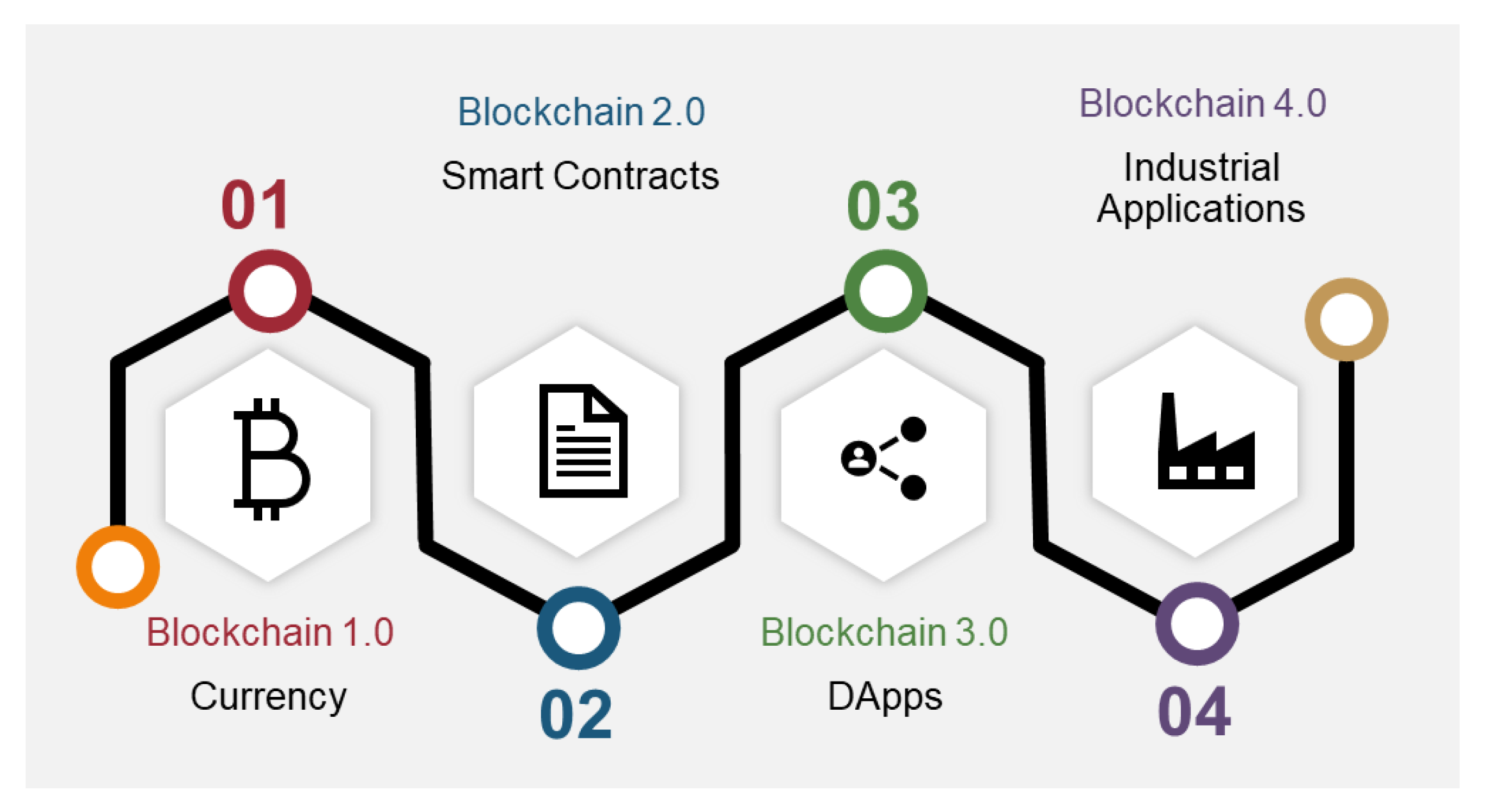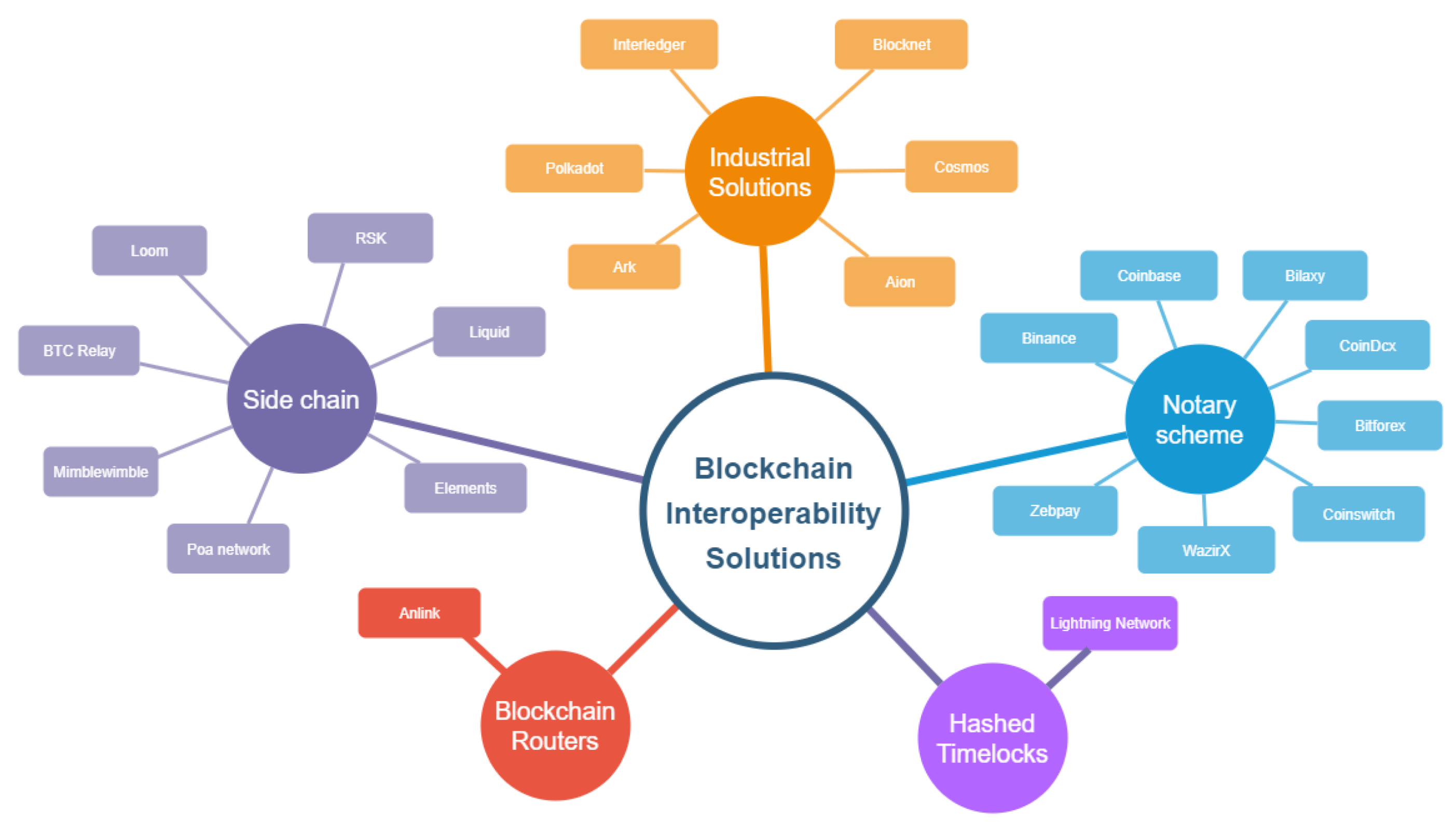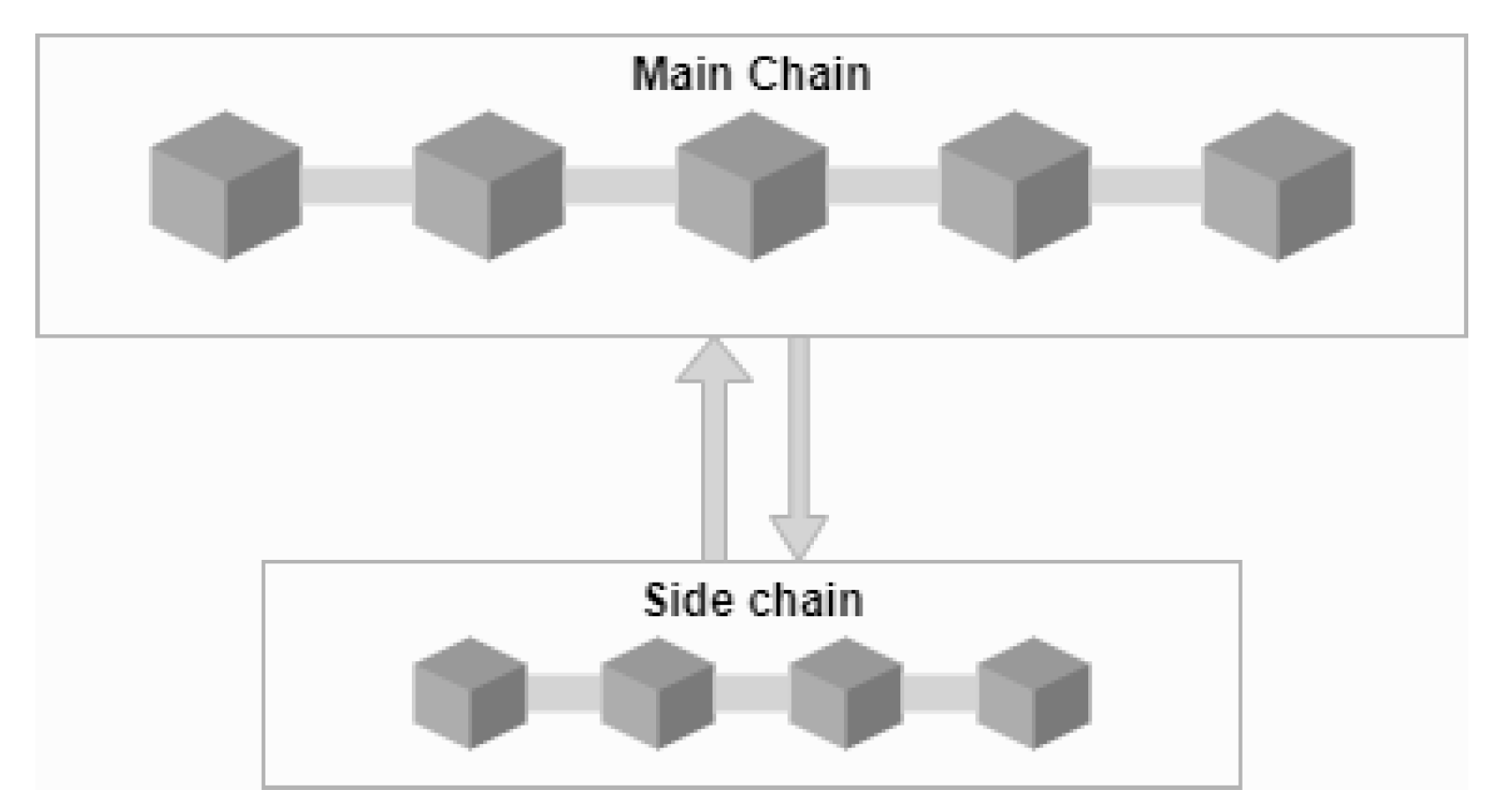Your browser does not fully support modern features. Please upgrade for a smoother experience.

Submitted Successfully!
Thank you for your contribution! You can also upload a video entry or images related to this topic.
For video creation, please contact our Academic Video Service.
| Version | Summary | Created by | Modification | Content Size | Created at | Operation |
|---|---|---|---|---|---|---|
| 1 | Debasis Mohanty | -- | 1187 | 2023-07-14 18:05:43 | | | |
| 2 | Jessie Wu | Meta information modification | 1187 | 2023-07-17 05:17:06 | | |
Video Upload Options
We provide professional Academic Video Service to translate complex research into visually appealing presentations. Would you like to try it?
Cite
If you have any further questions, please contact Encyclopedia Editorial Office.
Mohanty, D.; Anand, D.; Aljahdali, H.M.; Villar, S.G. Blockchain Interoperability. Encyclopedia. Available online: https://encyclopedia.pub/entry/46825 (accessed on 18 January 2026).
Mohanty D, Anand D, Aljahdali HM, Villar SG. Blockchain Interoperability. Encyclopedia. Available at: https://encyclopedia.pub/entry/46825. Accessed January 18, 2026.
Mohanty, Debasis, Divya Anand, Hani Moaiteq Aljahdali, Santos Gracia Villar. "Blockchain Interoperability" Encyclopedia, https://encyclopedia.pub/entry/46825 (accessed January 18, 2026).
Mohanty, D., Anand, D., Aljahdali, H.M., & Villar, S.G. (2023, July 14). Blockchain Interoperability. In Encyclopedia. https://encyclopedia.pub/entry/46825
Mohanty, Debasis, et al. "Blockchain Interoperability." Encyclopedia. Web. 14 July, 2023.
Copy Citation
Blockchain Interoperability is defined according to the National Institute of Standards and Technology (NIST) as: “a composition of distinguishable blockchain systems, each representing a unique distributed data ledger, where atomic transaction execution may span multiple heterogeneous blockchain systems, and where data recorded in one blockchain are reachable, verifiable, and referable by another possibly foreign transaction in a semantically compatible manner”.
blockchain
interoperabilit
exchange
1. Introduction
The idea of a chain of blocks called Blockchain was put forward by Satoshi Nakamoto in 2008 [1]. Nakamoto implemented the concept in a peer-to-peer decentralized cryptocurrency called Bitcoin. Blockchain is an immutable, append-only decentralized distributed ledger system that addresses the byzantine fault tolerance problem in centralized ledger systems. The development of Blockchain technology can be divided into four stages [2]. Blockchain 1.0 has cryptocurrency application, Blockchain 2.0 provides smart contracts whereas Blockchain 3.0 develops distributed applications (dapps) that cater to several fields beyond financial applications or asset transfers. Blockchain 4.0 includes industry 4.0 applications. The common use case of blockchain 1.0 is the electronic payment system or cryptocurrency. Different terminologies that refer to Blockchain 2.0 include Bitcoin 2.0, Bitcoin 2.0 protocols, smart contracts, smart property, etc. Ethereum Smart contracts [3], Hyperledger Fabric [4], and R3’s Corda [5] are examples of Blockchain 2.0. Common-use cases of Blockchain 3.0 include dapps for sectors such as governance, IoT, healthcare, supply chain, smart city, and many other non-financial applications. Blockchain 4.0 is focused on distributed ledger technology and real-life blockchain applications for industry 4.0 applications. Blockchain is currently used in several industries, in financial instruments, maintaining public/private records, health records, tangible assets, or intangible assets [6]. Figure 1 represents the evolution of blockchain.

Figure 1. Evolution of Blockchain.
Due to the wide array of applications of distributed ledger technologies, different organizations have developed their version of Blockchain systems, catering to their need. This led to the in-house development of different blockchain projects using different protocols and architectures. These projects use different technologies, consensus protocols catering to specific use cases or applications. Such a large number of projects have made the development highly fragmented with very little or no interoperability between different blockchain projects. For the wide acceptance of these blockchain-based applications, they need to communicate with other blockchain applications, that are hosted on different blockchain networks. This will create a new system of communication between different isolated blockchain networks, thereby laying a foundation for the concept of interoperability between blockchain networks [7].
2. Technologies for Blockchain Interoperability
A comprehensive literature survey on blockchain interoperability is provided by Belchior et al. [8]. The authors broadly categorized blockchain interoperability solutions into the following three categories: Cryptocurrency-directed Approaches, Blockchain Engines, and Blockchain Connectors. The three broad categories are divided into subcategories. Authors in [9] categorized inter-blockchain communications into four distinct groups, as follows: sidechains, blockchain routers, smart contracts, and industrial solutions. Robinson [10] organized cross-chain solutions into three categories value, namely, swap, cross-chain messaging, and state pinning techniques. Wang [11] discussed the current state of blockchain interoperability and broadly categorized blockchain interoperability solutions as chain-based, bridge-based, and dapp-based interoperability. In this section, researchers discuss the underlying technologies for cross-blockchain transactions. Researchers categorize them into notary schemes, sidechain-based solutions, Blockchain routers, Hashed time locks, and Industrial solutions. Many projects implement a combination of mentioned blockchain interoperability technologies. Figure 2 shows the blockchain interoperability solution types and example projects. Researchers classify cross-chain transactions as a special application and included them in the subsequent section.

Figure 2. Blockchain Interoperability solutions and example projects.
2.1. Sidechains
The sidechain has three important components, including the mainchain, sidechain, and cross-chain communication protocol. A sidechain is a mechanism in which two existing blockchains interoperate [12]. One blockchain is called the mainchain and the other is called the sidechain. The mainchain maintains a ledger of assets and is connected to the sidechain with a cross-chain communication protocol. Sidechains act as a two-way peg, with a mechanism to transfer assets between the mainchain and sidechain [13]. Figure 3 shows the side chain connected with the mainchain. BTC Relay [14] is the first project that introduced the concept of relay and sidechain. BTC relay uses a technique called simplified payment verification (SPV). Many lightweight clients use SPV to cryptographically verify if transactions in a blockchain are included without downloading the entire chain. A chain of block headers showing proof of work is held by an SPV client. Merkle tree validation can be achieved with a limited number of inputs and calculations until the root hash. Example projects that use the sidechain technology are Loom [15], Elements [16], Liquid [17], Mimblewimble [18], Poa network [19] and RSK [20].

Figure 3. Sidechain.
2.2. Notary Schemes
In this scheme, transactions are dependent on a third-party notary. The trust deficit between both the parties of the transaction is managed by a trusted exchange called a notary. Both the parties trust the exchange. The notary can be a centralized exchange or can be a network of exchanges. The operation of notary schemes is solely dependent on the honesty of the notary. However, notary schemes are simple and easy to implement. Another drawback of the scheme is that the presence of a centralized element though a group of notaries decentralizes the scheme. Currently available notary schemes are centralized cryptocurrency exchanges such as Binance [21], Coinbase [22], Bilaxy [23], BitForex [24], WazirX [25], Zebpay [26], CoinDcx [27], Coinswitch [28].
2.3. Blockchain Routers
The concept of blockchain routers was first introduced by Wang et al. [29] in 2017. Blockchain routers facilitate inter-blockchain communication between different blockchain networks. The design of blockchain routers is inspired by the role of routers over the Internet. In blockchain router network architecture, the different blockchain networks such as bitcoin, Ethereum, etc., are regarded as terminal parts called sub-chains in the routing network. Sub-chains cannot directly communication with each other, and they can only communicate with a blockchain router. Inter sub-chain communication is made possible through the blockchain router following a cross-chain communication protocol. A blockchain maintains all information registered on sub-chains. The blockchain router enables inter sub-chain communication and establishes trust bridge cross-chains. The authors introduced four distinct participants in blockchain router architecture as a validator, connector, surveillant, and nominator. The blockchain router uses a practical byzantine fault tolerance algorithm. Blockchain routers can implement different algorithms based on business logic and user requirements. The Anlink blockchain network [30] uses Ann-router to provide interoperability across blockchains.
2.4. Industrial Solutions
Industrial solutions are blockchain systems that are developed to cater to specific utilities. A few prominent industrial projects include COSMOS [31], Polkadot [32] and Interledger [33]. COSMOS consists of a network of independent blockchains called zones. Zones use a tendermint consensus protocol. The first zone in a COSMOS network is called a hub. Hub and zones communicate by an inter-blockchain protocol. Interzone token transfer undergoes the COSMOS hub. The COSMOS hub monitors the total amount of tokens held by each zone. Cosmos allows developers to build both permissionless and permissioned blockchains. Polkadot is a heterogeneous multi-chain translation architecture. It enables customized sidechains to connect with a public blockchain. Different blockchains can exchange messages in a secure and trustless manner with Polkadot. Polkadot defines three types of blockchain classes as Parachains, Relay chains, and bridges. The token used in Polkadot is called a dot. Polkadot implements nominated proof-of-stake consensus protocol. Ark [34] creates an ecosystem allowing interoperability by using ARK smart bridge technology. ARK smart bridges make connections between standalone blockchains. Other examples of major industrial blockchain interoperability solutions are Blocknet [35] and Aion [36].
References
- Nakamoto, S. Bitcoin: A Peer-to-Peer Electronic Cash System. 2008. Available online: https://bitcoin.org/bitcoin.pdf (accessed on 26 December 2020).
- Bodkhe, U.; Tanwar, S.; Parekh, K.; Khanpara, P.; Tyagi, S.; Kumar, N.; Alazab, M. Blockchain for Industry 4.0: A comprehensive review. IEEE Access 2020, 8, 79764–79800.
- Buterin, V. A Next Generation Smart Contract & Decentralized Application Platform. 2014. Available online: https://blockchainlab.com/pdf/Ethereum_white_paper-a_next_generation_smart_contract_and_decentralized_application_platform-vitalik-buterin.pdf (accessed on 6 January 2021).
- About the Hyperledger Architecture Working Group. Hyperledger architecture. Hyperledger. Org. 2017, 1, 15.
- Brown, R.G. The Corda Platform: An Introduction. 2018. Available online: https://www.corda.net/content/corda-platform-whitepaper.pdf (accessed on 6 January 2021).
- Bitcoin Series 24: The Mega-Master Blockchain List—Ledra Capital. Available online: http://ledracapital.com/blog/2014/3/11/bitcoin-series-24-the-mega-master-blockchain-list (accessed on 6 January 2021).
- Jin, H.; Xiao, J.; Dai, X. Towards A Novel Architecture for Enabling Interoperability Amongst Multiple Blockchains. In Proceedings of the 2018 IEEE 38th International Conference on Distributed Computing Systems (ICDCS), Vienna, Austria, 2–6 July 2018; pp. 1203–1211.
- Belchior, R.; Vasconcelos, A.; Guerreiro, S.; Correia, M. A Survey on Blockchain Interoperability: Past, Present, and Future Trends. ACM Comput. Surv. 2020, 54, 1–41.
- Qasse, I.A.; Talib, M.A.; Nasir, Q. Inter Blockchain Communication: A Survey. In Proceedings of the ArabWIC 6th Annual International Conference Research Track, Rabat, Morocco, 7–9 March 2019.
- Robinson, P. Survey of crosschain communications protocols. Comput. Netw. 2021, 200, 108488.
- Wang, G. SoK: Exploring Blockchains Interoperability. IACR Cryptol. Eprint Arch. 2021, 2021, 537.
- Back, A.; Corallo, M.; Dashjr, L.; Friedenbach, M.; Maxwell, G.; Miller, A.; Poelstra, A.; Timón, J.; Wuille, P. Enabling Blockchain Innovations with Pegged Sidechains. 2014. Available online: https://blockstream.com/sidechains.pdf (accessed on 6 January 2021).
- Singh, A.; Click, K.; Parizi, R.M.; Zhang, Q.; Dehghantanha, A.; Choo, K.K.R. Sidechain technologies in blockchain networks: An examination and state-of-the-art review. J. Netw. Comput. Appl. 2020, 149, 102471.
- GitHub-Ethereum/Btcrelay: Ethereum Contract for Bitcoin SPV: Live on. Available online: https://github.com/ethereum/btcrelay (accessed on 6 January 2021).
- Loom Network—Production-Ready, Multichain Interop Platform for Serious Dapp Developers. Available online: https://loomx.io/ (accessed on 7 January 2021).
- Elements|Elementsproject.org. Available online: https://elementsproject.org/ (accessed on 6 January 2021).
- Liquid Network: Sidechain for Traders|Blockstream. Available online: https://blockstream.com/liquid/ (accessed on 17 January 2021).
- Poelstra, A. Mimblewimble. 2016. Available online: https://download.wpsoftware.net/bitcoin/wizardry/mimblewimble.pdf (accessed on 16 January 2021).
- Welcome to POA-POA. Available online: https://www.poa.network/ (accessed on 16 January 2021).
- Lerner, S.D. RSK Rootstock Platform White Paper. 2019. Available online: https://www.rsk.co/Whitepapers/RSK-White-Paper-Updated.pdf (accessed on 17 March 2021).
- Buy/Sell Bitcoin, Ether and Altcoins|Cryptocurrency Exchange|Binance. Available online: https://www.binance.com/en (accessed on 17 January 2021).
- Coinbase—Buy & Sell Bitcoin, Ethereum, and More with Trust. Available online: https://www.coinbase.com/ (accessed on 2 January 2021).
- Bilaxy. Available online: https://bilaxy.com/ (accessed on 17 January 2021).
- BitForex|The World’s Leading One-Stop Digital Asset Service Platform. Available online: https://www.bitforex.com/ (accessed on 17 January 2021).
- Buy Bitcoin, Cryptocurrency at India’s Largest Exchange|Trading Platform|WazirX. Available online: https://wazirx.com/ (accessed on 17 January 2021).
- Buy Bitcoin and Cryptocurrency at India’s Leading Exchange|ZebPay. Available online: https://zebpay.com/in/ (accessed on 17 January 2021).
- CoinDCX-Crypto Exchange|Buy, Sell and Trade Bitcoins & Top Altcoins. Available online: https://coindcx.com/ (accessed on 17 January 2021).
- CoinSwitch Kuber-Cryptocurrency Exchange in India. Available online: https://coinswitch.co/ (accessed on 17 January 2021).
- Wang, H.; Cen, Y.; Li, X. Blockchain Router: A Cross-Chain Communication Protocol. In Proceedings of the 6th International Conference on Informatics, Environment, Energy and Applications, New York, NY, USA, 29–31 March 2017; pp. 94–97.
- Anlink Blockchain Network Whitepaper V 1.0. 2017. Available online: https://alicliimg.clewm.net/049/389/1389049/1484820492640c2baf37ea3e4f9fd77bd52c2a1e9bbbe1484820484.pdf (accessed on 17 January 2021).
- Whitepaper-Resources-Cosmos Network. Available online: https://v1.cosmos.network/resources/whitepaper (accessed on 17 January 2021).
- Wood, G. Polkadot: Vision For A Heterogeneous Multi-Chain Framework. 2016. Available online: https://polkadot.network/PolkaDotPaper.pdf (accessed on 17 January 2021).
- Thomas, S.; Schwartz, E. A Protocol for Interledger Payments. 2015. Available online: https://interledger.org/interledger.pdf (accessed on 18 January 2021).
- ARK Ecosystem Whitepaper Version 2.1.0. 2019. Available online: https://ark.io/Whitepaper.pdf (accessed on 20 January 2021).
- Culwick, A.; Metcalf, D. The Blocknet Design Specification. 2018. Available online: https://blocknet.co/whitepaper/Blocknet_Whitepaper.pdf (accessed on 7 September 2021).
- Aion Whitepaper-Whitepaper.io. Available online: https://whitepaper.io/document/31/aion-whitepaper (accessed on 26 January 2021).
More
Information
Contributors
MDPI registered users' name will be linked to their SciProfiles pages. To register with us, please refer to https://encyclopedia.pub/register
:
View Times:
1.8K
Revisions:
2 times
(View History)
Update Date:
17 Jul 2023
Notice
You are not a member of the advisory board for this topic. If you want to update advisory board member profile, please contact office@encyclopedia.pub.
OK
Confirm
Only members of the Encyclopedia advisory board for this topic are allowed to note entries. Would you like to become an advisory board member of the Encyclopedia?
Yes
No
${ textCharacter }/${ maxCharacter }
Submit
Cancel
Back
Comments
${ item }
|
More
No more~
There is no comment~
${ textCharacter }/${ maxCharacter }
Submit
Cancel
${ selectedItem.replyTextCharacter }/${ selectedItem.replyMaxCharacter }
Submit
Cancel
Confirm
Are you sure to Delete?
Yes
No




